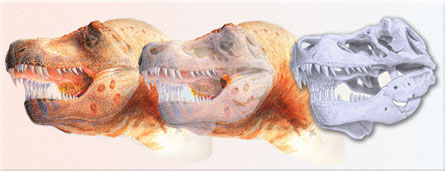The bug that may have killed a dinosaur
 |
| The holes in a T.male monarch jaw were probably left by a parasite, the sunrise work suggests. |
| Renderings by Chris Glen, University of Queensland |
Sue is a noted Tyrannosaurus rex whose skeletal frame lives in the Athletic field Museum in Chicago. Microscopic, quiet holes in Sue's jawbones wealthy person been a knowledge base mystery for years, and scientists want to get it on how they formed. Some researchers have believed, for exercise, that the holes resulted from a dino-along-dino fight.
Scientists whitethorn have solved the mystery in Sue's jaws. A new study suggests that the holes were caused by something so much smaller than other dinosaur. In the new study, researchers say the holes may have fall from infection away a midget parasite — and that infection may have killed the mighty dinosaur.
A parasite is an organism that cannot live on its own. Instead, IT feeds and lives on another organism. In Sue's case, the unrighteous parasite is called Trichomonas. Dissimilar the dinosaurs, which became out about 65 million age ago, different kinds Trichomonas placid live on the Earth.
In the rack up cases, a Trichomonas infection can grounds tissues to swell and block the throat. It can also cause the jaw to rot — and leave holes in the bones. These symptoms would be bad news for a T. rex with a difficult Trichomonas transmission. Unable to swallow food, the dinosaur would eventually give way of thirst or starve.
"There are some things you potty survive," Ewan Wolff, one of the researchers, told Science News. "Merely non having a gob in the vertebral column of your pharynx is non matchless of them."
Today, this parasite often infects such birds as pigeons, turkeys and chickens — and it was a bird that gave Wolff a clue. Wolff is a paleontologist at the University of Wisconsin–James Madison. He says the shapes, sizes and locations of the holes in Process's trounce are different than what you would expect if the holes had been caused by a dino agitate or by other kinda infection. So he and his colleagues started looking for another explanation, and they looked at the finger cymbals of modern font birds and crocodiles that had various diseases.
The scientists caught a break with the skull of an fish hawk, a fish-eating hawk easily recognized away its dark back and Theodore Harold White chest. The osprey had holes in its jaws similar to Sue's, and the scientists knew that when the bird was alive information technology was infected with Trichomonas. They started looking at other T. rex skulls and found nine, including Sue's, with the telltales holes of a Trichomonas transmission.
"Either this was a phenomenal coincidence, or this was a very common disease in T. rex," Wolff told Science Intelligence about the match betwixt the osprey and Sue.
Scientists aren't doomed how the T. rex caught the parasite. Peradventure information technology Ate an infected animal. Wolff says the parasite may also have been spread from dino to dino through face-biting operating theater cannibalism.
POWER WORDS (adapted from the Yahoo! Kids Dictionary)
parasite An organism that grows, feeds and is sheltered on or in a different organism while tributary zipp to the survival of its host
paleontologist A scientist who studies the forms of aliveness that existed in prehistoric or geologic times, as represented by the fossils of plants, animals and other organisms
infection When a disease-causing microorganism invades and multiplies in a body part or weave, possibly causation more tissue trauma and life-threatening disease.
extinct No thirster existing or living, usually aforesaid of an entire species.

0 Response to "The bug that may have killed a dinosaur"
Post a Comment